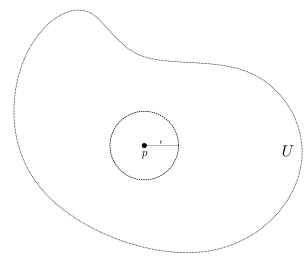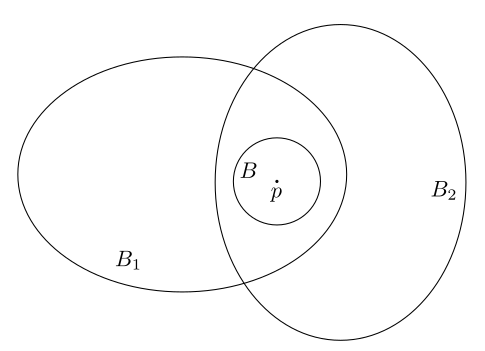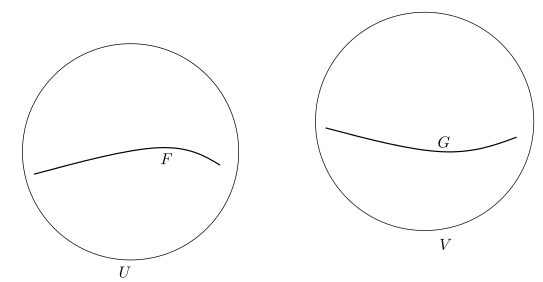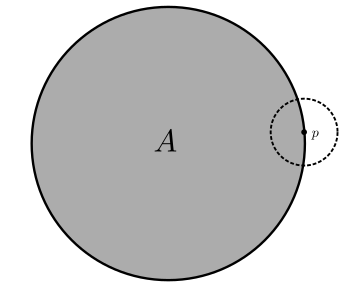Topology
A topology on a set is a collection of subsets such that
- (Arbitrary union) if for all , then
- (Finite intersection) if , then .
We call elements of a topology open sets and the pair a topological space. A neighborhood of a point is an open set that contains .
Example: The standard topology for consists of sets that are open if and only if for every , there is a open ball with center and radius contained in .

If and are both topologies of and , then we say that is finer than . Or equivalently, is coarser than .
Local criterion for openness
Let be a topological space. A subset is open in if and only if for every , there is an open set such that .
Proof: (): Clearly for all . (): Notice that for each there is a open set . But,
and the arbitrary union of open sets is open.
Q.E.D.
A set is called closed if it’s complement is open. By the use of de Morgan’s laws, one can redefine a topology in terms of closed sets.
Topology
A topology on a set is a collection of subsets such that
- and are closed
- (Arbitrary intersection) if is closed for all , then is closed.
- (Finite union) if are closed, then is closed.
Subspace Topology
Let be a topological space and . Define to be the collection of subsets
By the distributive property of union and intersection, one may show that is closed under arbitrary union and finite intersection. Moreover, . Thus, is a topology on called the subspace topology.
Example: Consider the subset of . In the subspace topology, the half-open interval is open relative to since
and is open in .
Bases
Instead of explicitly stating all the possible open sets, we often make use of the local criterion for openness and define a basis of sets.
Basis
A subcollection of a topology on a topological space is a basis for if given an open set and a point , there is an open set such that . We say that generates the topology .
Example: The standard topology for is generated by the collection of open balls
for all and .
Prp
A collection of open sets of is a basis if and only if every open set in is a union of sets in .
Proof: (): Let be open. Since is a basis, there are open sets for each . Notice that
): Let be open and . Since with each , there is some such that . Thus, is a basis.
Q.E.D.
Prp
A collection of subsets of a set is a basis for some topology on if and only if
- is the union of all sets in ; and
- given any two sets and a point , there is a set such that .

Proof: ():
- See previous proposition.
- Since is a basis, and are open. Hence, by the definition of basis, there is a such that .
(): Let be the collection of all sets that unions of set sin . Note that . Clearly, an arbitrary union of sets in is in . For finite intersection, let and be sets in . Notice that
Hence, for any , it follows that for some . By property (2), there is a set such that . Therefore,
Hence, is a topology.
Q.E.D.
Prp
Let be a basis for a topological space , and a subspace of . Then is a basis for .
Proof: Let be open relative to , i.e., for some open set in . Since is a basis for , it follows that . Notice that
Q.E.D.
First and Second Countability
Second countable
A topological space is second countable if it has a countable basis.
Example: is second countable since it is generated by the collection of open balls in with rational centers and rational radii.
Prp
A subspace of a second-countable space is second countable.
Proof: Follows from proposition 7.
Q.E.D.
First Countable
Let be a topological space and . A basis of neighborhoods at is a collection of neighborhoods of such that any neighborhood of , there is a such that . A topological space is first countable if it has a countable basis of neighborhoods at every point .
Example: For any , the collection is a countable neighborhood basis at . Thus, is first countable.
Example: An uncountable discrete space is first countable but not second countable.
Separation Axioms
Hausdorff
A topological space is Hausdorff if given any two distinct points , there exists disjoint open sets such that and . A Hausdorff space is normal if given any two distinct closed sets in , there exists disjoint open sets such that and .

Example: is Hausdorff since any two distinct points can be put in disjoint balls and ) for . Moreover, it is also normal.
Prp
Every singleton set in a Hausdorff space is closed.
Proof: Let . Notice that for any there is open sets and such that , and . Notice that . Therefore, is open implying that is closed.
Q.E.D.
Prp
Any subspace of a Hausdorff space is Hausdorff.
Proof: Let be distinct points. Then so there are disjoint open sets and such that and . Notice that , and
Therefore, is Hausdorff.
Q.E.D.
Product Topology
Given two topological spaces . Consider the collection of subsets of where is open in and is open in . Then is the basis for a topology on known as the product topology.
Prp
Let and be bases for topological spaces and , respectively. Then is a basis for .
Proof: Let be open in and . Since is open, there is an open set in such that where is open in and is open in . Notice that there is some such that and such that . Therefore,
Therefore, is a basis for .
Q.E.D.
Example: The collection of open rectangles is a basis for .
Cor
The product of two second-countable spaces is second-countable.
Prp
The product of two Hausdorff spaces and is Hausdorff.
Proof: Let . WLOG, assume that . Since is Hausdorff, there are disjoint open sets such that and . Notice that and are disjoint neighborhoods of and , respectively.
Q.E.D.
Continuity
Let be a function between topological spaces. We say that is continuous at a point in if for every neighborhood of in , there is a neighborhood of in such that .
Prp
A function is continous if and only if is open for any open set .
Cor
A function is continuous if and only if is closed for any closed set .
Example: If is a subspace of , then the inclusion map , , is continuous. Indeed, if is open in , then is open in .
Example: The projection map given by is continuous. Indeed, if is open in , then is open in .
Prp
The composition of two continuous maps is continuous.
Proof: Let and be continuous. Then for open in ,
is open in since is open in .
Q.E.D.
Cor
The restriction of a continuous function to a subspace is continuous.
Proof: The restriction is the composition where is the inclusion map.
Q.E.D.
We call a map open if the image of every open set in is open in . Likewise, it is called closed if the image of every closed set in is closed in .
Compactness
We call a collection of open sets an open cover of if . A subcover is a subcollection of an open cover that still contains . We say a topological space is compact if every open cover has a finite subcover.
Example: Any closed interval is compact.
Prp
A subspace of a topological space is compact if and only if every open cover of in has a finite subcover.
Prp
A closed subset of a compact topological space is compact.
Proof: Let be an open cover of . Notice then that is a open cover of . Since is compact, there is a finite subcover . Thus, .
Q.E.D.
Prp
In a Hausdorff space , it is possible to separate a compact subset and a point by disjoint open sets, i.e., there exists an open set and a neighborhood of such that .
Proof: Since is Hausdorff, for each there are disjoint neighborhoods of and of . Notice that forms an open cover of , hence there is a finite subcover . Let and . Notice that is open and . Moreover is open and since each contains . Notice that
Q.E.D.
Prp
Every compact subset of a Hausdorff space is closed.
Proof: Let . By the previous proposition, there is an open set containing such that . Thus, is open.
Q.E.D.
Prp
The image of a compact set under a continuous map is compact.
Proof: Let be a continuous map and a compact subset of . Consider an open cover of . Since is continuous, is a collection of open sets in . Notice that
Thus, there is a finite subcover of . Notice that
Q.E.D.
Prp
A continuous map from a compact space to a Haudorff space is a closed map.
Proof: Let be closed in . By proposition 22, is compact. By proposition 25, is compact. By proposition 24, is closed.
Q.E.D.
A continuous bijection whose inverse is also continuous is called a homeomorphism.
Cor
A continuous bijection from a compact space to a Hausdorff space is a homeomorphism.
Thm
The product of compact spaces is compact in the product topology.
Boundedness in
A subset of is called bounded if there is an open ball containing . Otherwise it is unbounded.
Prp
A compact subset of is bounded.
Proof: Let be a compact subset and consider the open cover of . Since is compact, it follows that is contained in a single ball .
Q.E.D.
Heine-Borel
A subset of is compact if and only if it is closed and bounded.
Connectedness
Connected/Disconnected
A topological space is disconnected if it is the union of two disjoint nonempty open subsets and . It is connected if it is not disconnected.
A subset is disconnected if it is disconnected in the subspace topology.
Prp
A subset of a topological space is disconnected if and only if there are open sets and in such that
A pair of open sets in with these properties is called a separation of .
Proof: ): If is disconnected, then there are disjoint non-empty open sets and such that . Thus, there are open sets in such that , . Notice that
and
(): Let and . Notice that are open in ,
and
Q.E.D.
Prp
The image of a connected space under a continuous map is connected.
Closure
Let be a topological space and a subset of . The closure of in , denoted or , is defined to be the intersection of all closed sets containing . In other words, it is the smallest closed set containing .
Example: The closure of the open disk in is the closed disk
Prp
Let be a subset of a topological space . A point is in the closure if and only if every neighborhood of contains a point of .

Proof: We prove the contrapositive.
): Suppose
Then for some closed set in . But is open and disjoint from .
): Let be in a open set disjoint from . Notice that then is a closed set containing and not containing . Thus, .
Q.E.D.
We call a point an accumulation point of if every neighborhood of in contains a point of other than . We denote the set of accumulation points by . Some texts refer to accumulation points as limit points.
Example: For in , the closure of is but the set of accumulation points of is .
Prp
Let be a subset of a topological space . Then .
Convergence
Let be a topological space. A sequence in is a map from the set to . We typically write or .
We say a sequence converges to if for every neighborhood of , there is some such that implies that . We often write this as or . Not every sequence converges, in such a case we say it diverges. For example the sequence in diverges.
Prp
Let be a Hausdorff space. If converges to and to , then .
Proof: Assume . Then since is Hausdorff, there are neighborhoods and of and respectively such that . Since there is some such that whenever . Likewise, there is some such that whenever . Then it follows that for , .
Q.E.D.
This uniqueness property does not hold in general. The simplest counterexample is any non-empty set with the trivial topology . In such a space a sequence converges to every point .
The sequence lemma
Let be a topological space and a subset of . If there is a sequence in such that , then . The converse is true if is first countable.